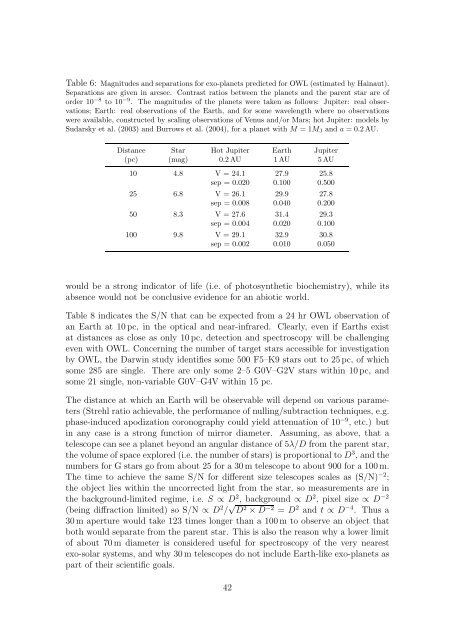Report - School of Physics
Report - School of Physics
Report - School of Physics
Create successful ePaper yourself
Turn your PDF publications into a flip-book with our unique Google optimized e-Paper software.
Table 6: Magnitudes and separations for exo-planets predicted for OWL (estimated by Hainaut).<br />
Separations are given in arcsec. Contrast ratios between the planets and the parent star are <strong>of</strong><br />
order 10 −8 to 10 −9 . The magnitudes <strong>of</strong> the planets were taken as follows: Jupiter: real observations;<br />
Earth: real observations <strong>of</strong> the Earth, and for some wavelength where no observations<br />
were available, constructed by scaling observations <strong>of</strong> Venus and/or Mars; hot Jupiter: models by<br />
Sudarsky et al. (2003) and Burrows et al. (2004), for a planet with M = 1M J and a = 0.2 AU.<br />
Distance Star Hot Jupiter Earth Jupiter<br />
(pc) (mag) 0.2 AU 1 AU 5 AU<br />
10 4.8 V = 24.1 27.9 25.8<br />
sep = 0.020 0.100 0.500<br />
25 6.8 V = 26.1 29.9 27.8<br />
sep = 0.008 0.040 0.200<br />
50 8.3 V = 27.6 31.4 29.3<br />
sep = 0.004 0.020 0.100<br />
100 9.8 V = 29.1 32.9 30.8<br />
sep = 0.002 0.010 0.050<br />
would be a strong indicator <strong>of</strong> life (i.e. <strong>of</strong> photosynthetic biochemistry), while its<br />
absence would not be conclusive evidence for an abiotic world.<br />
Table 8 indicates the S/N that can be expected from a 24 hr OWL observation <strong>of</strong><br />
an Earth at 10 pc, in the optical and near-infrared. Clearly, even if Earths exist<br />
at distances as close as only 10 pc, detection and spectroscopy will be challenging<br />
even with OWL. Concerning the number <strong>of</strong> target stars accessible for investigation<br />
by OWL, the Darwin study identifies some 500 F5–K9 stars out to 25 pc, <strong>of</strong> which<br />
some 285 are single. There are only some 2–5 G0V–G2V stars within 10 pc, and<br />
some 21 single, non-variable G0V–G4V within 15 pc.<br />
The distance at which an Earth will be observable will depend on various parameters<br />
(Strehl ratio achievable, the performance <strong>of</strong> nulling/subtraction techniques, e.g.<br />
phase-induced apodization coronography could yield attenuation <strong>of</strong> 10 −9 , etc.) but<br />
in any case is a strong function <strong>of</strong> mirror diameter. Assuming, as above, that a<br />
telescope can see a planet beyond an angular distance <strong>of</strong> 5λ/D from the parent star,<br />
the volume <strong>of</strong> space explored (i.e. the number <strong>of</strong> stars) is proportional to D 3 , and the<br />
numbers for G stars go from about 25 for a 30 m telescope to about 900 for a 100 m.<br />
The time to achieve the same S/N for different size telescopes scales as (S/N) −2 ;<br />
the object lies within the uncorrected light from the star, so measurements are in<br />
the background-limited regime, i.e. S ∝ D 2 , background ∝ D 2 , pixel size ∝ D −2<br />
(being diffraction limited) so S/N ∝ D 2 / √ D 2 × D −2 = D 2 and t ∝ D −4 . Thus a<br />
30 m aperture would take 123 times longer than a 100 m to observe an object that<br />
both would separate from the parent star. This is also the reason why a lower limit<br />
<strong>of</strong> about 70 m diameter is considered useful for spectroscopy <strong>of</strong> the very nearest<br />
exo-solar systems, and why 30 m telescopes do not include Earth-like exo-planets as<br />
part <strong>of</strong> their scientific goals.<br />
42
















